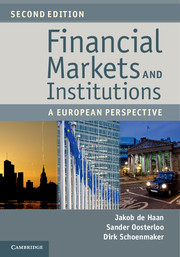Book contents
- Frontmatter
- Contents
- List of Boxes
- List of Figures
- List of Tables
- List of Countries
- List of Abbreviations
- Preface
- Part I Setting the Stage
- Chapter 1 Functions of the Financial System
- Chapter 2 Financial Crises
- Chapter 3 European Financial Integration
- Chapter 4 Monetary Policy of the European Central Bank
- Part II Financial Markets
- Part III Financial Institutions
- Part IV Policies for the Financial Sector
- Index
- References
Chapter 2 - Financial Crises
from Part I - Setting the Stage
- Frontmatter
- Contents
- List of Boxes
- List of Figures
- List of Tables
- List of Countries
- List of Abbreviations
- Preface
- Part I Setting the Stage
- Chapter 1 Functions of the Financial System
- Chapter 2 Financial Crises
- Chapter 3 European Financial Integration
- Chapter 4 Monetary Policy of the European Central Bank
- Part II Financial Markets
- Part III Financial Institutions
- Part IV Policies for the Financial Sector
- Index
- References
Summary
Overview
Financial crises have been pervasive phenomena throughout history. This chapter starts by exploring the different types of crises: banking crises, sovereign debt crises, and currency crises. In a banking crisis a significant part of a country’s banking sector has become insolvent after heavy investment losses, banking panics, or both. A sovereign default occurs when a government fails to meet interest or principal payments on its debt obligations. Finally, in a currency crisis the value of a country’s currency falls precipitously.
This chapter fi rst provides facts and fi gures about fi nancial crises, after which some theoretical models are discussed. A first set of models is related to the liability side of banks. As banks finance long-term loans with short-term deposits, they are vulnerable to massive withdrawals cumulating in a banking run. A second set of models looks at the asset side of banks. Banking problems arise from deteriorating asset quality. This decline in assets is closely related to the business cycle, resulting from shocks to fundamentals.
In 2007–2009, the world’s fi nancial system went through its greatest crisis for at least a century. What made this crisis unique was that severe fi nancial problems emerged simultaneously in many different countries, and its economic impact was felt throughout the world as a result of the increased interconnectedness of the global economy. The second part of this chapter offers an overview of the causes and consequences of this crisis. This crisis was followed by a sovereign and banking crisis in Europe which is discussed in the final part of this chapter.
- Type
- Chapter
- Information
- Financial Markets and InstitutionsA European Perspective, pp. 39 - 70Publisher: Cambridge University PressPrint publication year: 2012



